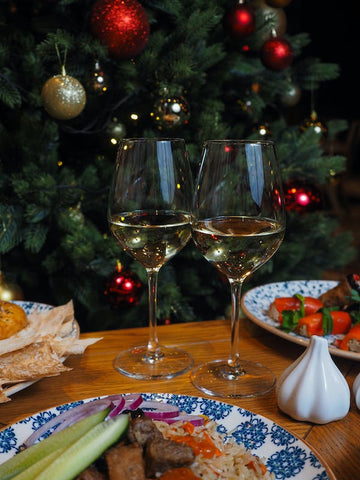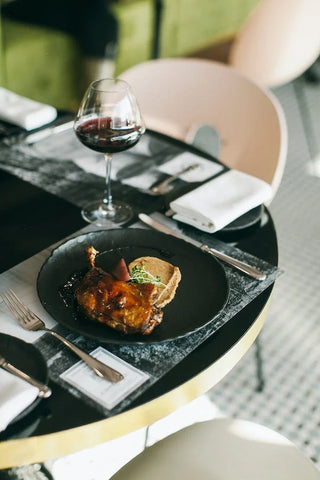You don't need to understand complex processes to choose the wine that best complements your meal when you pair it with food. This is a simple topic; you can make compelling wine and food combinations by following a few basic rules.
Of course, experimenting and perfecting are enjoyable, and with practice, you might make amazing pairings that significantly enhance both the cuisine and the wine. However, save those efforts for special events and wines. But this article will show you thirteen simple rules you should follow when pairing food and wine. Read along to learn more.
Food and Wine Pairing

Why food and wine pairing are quite a subject among wine experts. The answer to why people worry about this one often is because it improves a guest's dining experience[1], and it displays an effort to bring out the flavours of both the food and the wine. There is much room for creativity to impress your audience because it is more of a subjective procedure than an exact science.
To put it briefly, you should keep two pairing methods in mind, which are congruent and complementary pairing[2].
1. Congruent Pairing
The selected food and wine will share several tastes or ingredients for congruent pairing. This can involve a sweet wine coupled with a sweet dish or a buttery pasta dish and a red wine with a buttery aftertaste. The key to developing congruent pairings is to ensure that the food's flavours don't overpower the wine.
When this happens, the wine may lose some of its flavour. A complementary pairing allows the flavours of the wine and the meal to complement one another. Red wines are a fantastic choice when trying to make complementary pairings. Red wines have various flavours and smells, from cherry to smokey, making them simple to pair with similar dishes. A full-bodied Syrah wine is a fantastic complementary pairing because it has a flavour profile similar to some of your favourite grilled meats.
2. Complementary Pairing
Contrarily, complementary pairings focus on combinations of food and wine that don't share any components or flavours but rather enhance one another. Their conflicting qualities serve to balance the flavours of each.
White, sparkling, and rosé wines are all great options for contrasting dishes. When served with a hot dish, a sweet white wine will allow the wine's sugar to chill and counteract the heat.
White wine with salty foods is another typical complementing match. The wine's sweetness is reduced by the saltiness of the meal, which also enhances the fruity flavours and aromas of the wine. Salty popcorn and fried foods go exceptionally well with a drink of Chardonnay or Pinot Grigio.
Thirteen Rules in Food and Wines Pair

Now that you know the brief information you need in food and wine pairing and its pairing methods, you can start planning them. To make sure that you’d have a smooth pairing process, all you need to do is follow the rules we have prepared below:
1. Don't let your pairing plans keep you up at night.
Before planning it, we know food and wine pairing is also exciting and overwhelming. There are some fantastic matches where the wine and meal are improved, and there are also some errors. However, wine and food often don't affect one another to the extent that a poor match will ruin the meal. Though entertaining, wine and food matching is fine. So, all you need to do is enjoy and savour the planning process and don’t stress too much about it.
2. Beforehand, prepare versatile wines
The most adaptable wines to combine with food are those with high acidity and a little sweetness. Riesling is one of the most adaptable grape varieties since it often has some sweetness and good acidity. Meanwhile, lightly oaked, medium-bodied, fruity wines like Pinot Noir, Merlot, Viognier, and Chardonnay will also go well with various dishes.
3. Don't confine yourself to rules
Pairing rules are only there to serve as your guidelines. Although there are some exceptions, white wines often pair better with seafood than red wines. Red wine would go well with grilled tuna sauced with a red wine reduction; a mild Pinot Noir or Merlot pairs well with swordfish. "If it grows together, it goes together" is another cliche. Alternatively, match wines from a particular region with dishes from that region.
This is a helpful generalisation because specific locations have a long history of producing wine that complements their cuisine. However, remember that following this rule limits your options because many places of the world, if they grow grapes at all, only cultivate a select few varieties.
4. Always match wine to the prominent flavour of a dish.
Sweet flavours will prevail when mango salsa is spread over grilled chicken breast. The primary flavours in chicken piccata will be the tart lemon and salty capers, which should impact your wine selection. Thus, remember to find a wine that matches your food's prominent flavour or basic taste component.
5. Think about the pairing’s sweetness level
At a minimum, the wine should be as sweet as the meal. If not, the wine will taste sour and flat. You may avoid this problem by ensuring a touch of sweetness can also counter spicy heat. Desserts should adhere to this rule as well. A dessert wine should be sweeter than the food. But acidity is also necessary for dessert wines to soothe the palate. It is safe to use Recioto di Soave or Muscat de Beaumes de Venise for this.
6. After sweetness, match the pairing's flavour and intensity
Wine and food flavours that are similar are complementary. For instance, pinot gris and fish with lemon sauce have citrus flavours and go well together. Pair mild wines with mild dishes. Big, flavorful wines should be paired with big, savoury dishes. Consider combining pepper steak with a hot, powerful shiraz. Similarly, you should usually pair a rich wine with a rich meal. For instance, serve a rich chardonnay with chicken in a cream sauce.
7. Keep similar weight with the food and wine
After knowing your food's sweetness level, flavour and intensity, you must find its weight and balance. We do not refer to weight in terms of pounds or kilograms. We're talking about mixing lighter foods (usually lower in fat) with lighter-type wines and heavier, more decadent foods with heavier-weight wines when we talk about matching food weight to the wine.
More delicate wines go well with comfort food like poultry and fish. White wine is a natural choice, but light, low-tannin reds also work well. Chardonnay and prawns are complementary foods because they are both medium-weight and rich. Meanwhile, Shiraz is a full-bodied wine that pairs well with heavier dishes like red meat casseroles.
8. Remember the pairing’s acidity level
The acidity makes a pairing shine, and acidic wines typically have the widest range of applications. Acidity can counterbalance fried meals, cut through a dish's richness, combat tart elements, and leave you salivating for the next bite.
Young riesling and other high-acid wines frequently cleanse the palate after eating fatty foods like Indian curries or thick, buttery sauces. Pair a crisp, dry pinot grigio with a dish that contains a lot of acids, such as a salad with a vinegar-based dressing.
Compared to wines from hot regions, those from cool climes (like the Mornington Peninsula) will have more excellent acidity. Remember that an acidic wine like a sparkling would typically conflict with rich, creamy foods.
9. Keep an eye on alcohol and tannin.
Tannin is a phenol that contributes to the drying taste of red wines and supports a long aftertaste. Tannins are fat absorbers, which is why Cabernet Sauvignon pairs nicely with most steaks, but they can also sometimes heighten harshness. High alcohol levels make wine feel heavy, syrupy, and occasionally even harsh. Alcohol and tannins make spicy food taste spicier and bitter food taste more bitter. High quantities of tannin and alcohol combine best with hearty, savoury foods like roasted meats, but keep track of the amount of spice.
10. Watch out in mixing tannin and salt
Salty flavours are balanced with crisp, acidic wines. For instance, our pal sauvignon blanc harmonises feta cheese and salty olives. But a little sweetness also improves and balances salty dishes. The same may be done with wine: cool-climate pinot gris or any slightly sweet wine, such as Sauternes, a lusciously sweet wine from the Bordeaux region, is a famous pairing with salty, spicy Roquefort cheese.
However, be careful because salt can affect tannin, making it feel bitier; therefore, stay away from big, gripping reds like cabernet sauvignon and shiraz. Look for a dry wine with minimal tannins and pronounced acidity that will go well with salty food. Look for savoury wines rather than fruity, like a French Chablis. With time, good chardonnay develops a lovely nutty depth that pairs superbly with semi-hard and hard cheese.
11. Match spicy wine with spicy food
Sweeter wines provide a counterbalance to hot dishes. Strong spices can clash and ruin the flavours of wine, as spicy chilli peppers in Thai or Indian food. Wine is typically not the best beverage to consume.
If wine is more your style, though, think about something hot and sweet on its own, such an off-dry Gewürztraminer or Riesling.
12. Enhance the sauce using pairing methods
Use your complementary and congruent pairing strategies to match the wine to the sauce served. For instance, pair chardonnay and sauvignon blanc with cream and mushroom sauces, red and meat sauces with shiraz, and delicate citrus sauces with those wines. But if you don't have a sauce, it's totally fine to pair the wine with meat, fish, or chicken.
13. Let your pairing capture everyone’s attention
Let your fantastic bottle of wine take centre stage if you have one. Feel free to recommend a straightforward food highlighting the wine. This is particularly valid if the wine has matured. If the food is overly flashy, the subtle taste of aged wines will be lost. Instead, choose a simple, versatile wine that will be distinct from the dish's complex flavours.
Suggested Food and Wine Pairings Here at Kendricks Familia Imports

If you need recommendations on which food will be best paired with our products, then you’re lucky because we have also listed them for you. Choose which is the most suitable for your next special occasion and will pair well with the dishes you have in mind!
For Our Selection of White and Rose Wine

1. Quinta de Gomariz Alvarinho White 2020
You can pair a bottle of our Quinta de Gomariz Alvarinho White 2020 with several dishes. Various seafood and land-based dishes go well with albario, especially those that include white fish, meat, and fresh green herbs.
Pair it with cooked seafood dishes like fish tacos, raw seafood dishes like ceviche, or a seafood risotto (grilled or fried).
2. Quinta de Gomariz Loureiro White 2020, Palácio da Brejoeira Alvarinho White 2019, Vinho Verde Azul Portugal Escolha White 2020, Vinho Verde Azul Portugal Reserva 2019, and Mar de Frades Albarino Wine 2020
These semi-aromatic wines demand equally tasty and textured food due to their considerable bulk and weight. You may pair them with Portuguese delicacies like salt cod or fish soup.
Meanwhile, they also pair well with shellfish since this crispy, mineral wines frequently work best with raw, metallic, salty seafood. Most shellfish have mild flavours, but some, like scallops, may withstand being combined with other strong foods like bacon or chile. When pairing, those factors must be considered equally. These wines of ours may also be served with squid and octopus dishes.
3. Mateus Rosé Original
Tomatoes are highly acidic, so light, crisp wines mix well with tomato-heavy dishes like our Mateus Rosé Original.
Along with pasta topped with fresh tomato sauce, salads, fresh tomato sauces, salsas, and gazpachos go nicely with this wine. Make sure to include plenty of vegetables and lighter seafood ingredients with it.
4. Castelo de Medina Sauvignon Blanc 2020
For a warm summer evening or a chilly winter night when you're yearning for summer flavours, a grilled Caesar salad is the ideal entrée with our Castelo de Medina Sauvignon Blanc 2020, which is a light and refreshing wine.
You can enjoy the delicate flavour of romaine lettuce with a dry, light-bodied wine like Sauvignon Blanc. The fresh herbs and vegetables in the salad pair beautifully with the herbal undertones of the wine.
For Our Selection of Red Wine

Here at Kendricks Familia Imports, we only offer three red wines: Fat Baron Shiraz Casa Ermelinda Freitas 2020, Monte das Servas Selection Red 2019, and San Roman Tinto de Toro Red 2018.
The best dishes you could pair with these wines are those containing beef and venison. The general rule for all red meat is that the lighter the wine, the leaner the meat; this rule generally holds for various slices of beef or steak, though side dishes and sauces must also be taken into account. Thus, our red wines go well with these types of cuisines.
For Our Selection of Vermouth and Fortified Wine

1. Porto Cruz White Port, Red Vermouth Lacuesta Rojo, and Porto Cruz 30-Year-Old Vintage Port
These wines of ours go well with desserts, especially fruit-based desserts. These will work well, too if you can picture pouring a caramel or butterscotch sauce over your dish, and they go well with a variety of fruits, including bananas, or banana pie, for example.
2. Porto Cruz Ruby Port and Porto Cruz Late Bottle Vintage 2003
The flavours of chocolate range from white to black, and while the greatest wine pairings are not always universal, they work well with these specific wines of ours.
Given rich, premium chocolate, white chocolate may be matched rather easily despite not containing any cocoa. Red Port is typically paired with a darker chocolate, but white Port can also be used to create a striking pairing similar to berries and cream.
In Conclusion
The most important thing to remember is that wine and food pairing is subjective and totally up to you. Yes, there are some basic criteria for pairing wine and food, but these are not absolute truths. You may follow our recommended food and wine pairings, but the decision is yours. Follow your preferences, and you won't go wrong.
On the other hand, if you're looking for a wine for your next occasion that will go well with your planned dishes, go ahead and shop here at Kendricks Familia Imports to see which wine is the best for you!

